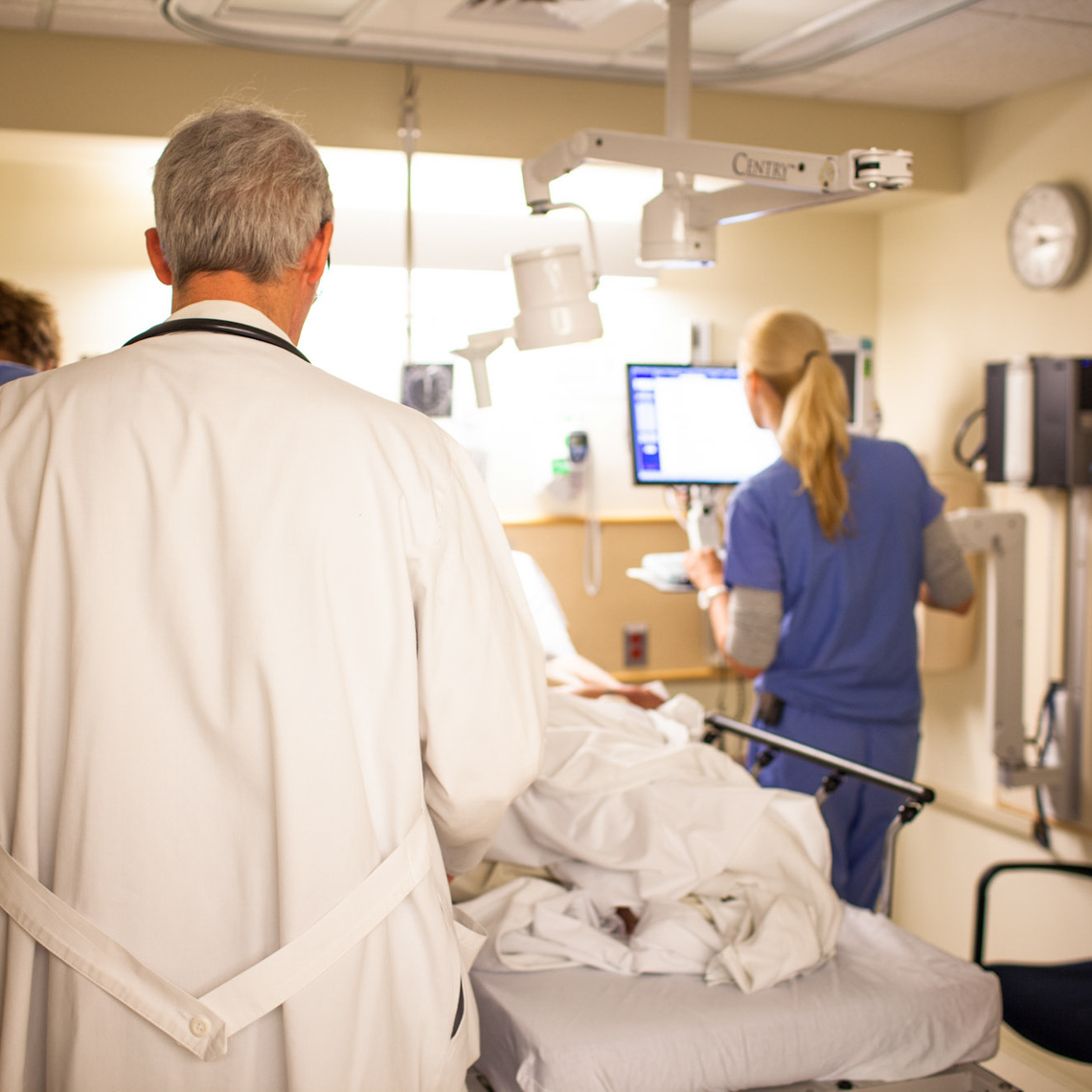Article
Simulating Emergencies to Prevent Errors
Summary
Various specialties go to ED simulator to learn how to manage high acuity, low frequency events. September 2005
Commentators
-
Stephen Nelson; STRATUS Center for Medical Simulation; Boston, MA
-
Charles Pozner, MD; Brigham and Women’s Hospital; Boston, MA
Transcript
[audio: operating room sounds]
This is the sound of something going very badly for a patient rushed into the emergency room after his boat collided with a concrete pylon. The providers are making mistakes and not collaborating very well. Which is exactly as it should be, since the patient is actually made of rubber and his vital signs are fabrications of a computer.
It’s all taking place at the STRATUS Center, a simulator at Brigham & Women’s Hospital in Boston. Anyone from EMS workers to residents to attendings gets additional training there. In addition to skills training, they learn about working as a team to enhance communication and efficiency.
This ED simulator is part of a growing trend that started in anesthesia and is now branching out into surgery and other high-stakes environments. Some professional liability insurers have taken a keen interest in these efforts because of the potential to reduce risk and errors that hurt patients and lead to lawsuits.
Dr. Charles Pozner says emergency medicine is a good place for the high-tech make-believe training scenarios. Dr. Pozner is Medical Director of the STRATUS Center for Medical Simulation in the Department of Emergency Medicine at Brigham & Women’s.
“I think the thing that’s well suited in emergency medicine is the potential high acuity of what we see. We do a lot of low-frequency, high acuity events which are clearly suited to a simulated environment, although we have also done fluid and electrolyte imbalances utilizing our simulation center.”
Dr. Pozner says a number of factors are combining at this time to make simulation training more attractive: increased attention on medical error; reduced willingness by patients to be practiced upon by residents; and a lowering of the costs associated with simulation equipment. Although Brigham & Women’s ED simulator cost more than $1 million, Dr. Pozner says more modest simulators could be set up for about $100,000 or even less. Not everyone needs 17 plasma screens.
“I think probably a large group practice could do it. However, one thing I will say is that you need a committed group of individuals who can actually run the center, that know how to use the technology, that have the time to develop the courses and the training and run the courses. Although there is a capital investment in equipment, I think there also needs to be an investment of human resources and time so that you can get the most out of your equipment.”
A wide variety of courses can be adapted to use the center. Despite the specialization in emergency medicine, the STRATUS Center attracts participants from other disciplines. Courses have been developed for the department of medicine, surgery, anesthesia, radiology and dentistry.
“One of the courses that I’m most proud of is a course that we have developed for nursing home nurses in how to manage common medical emergencies. We have put 200 nurses through a full-day simulation program to try to improve their ability to manage cases that they are presented with on a daily basis. The biggest problem with the nursing homes is that although they are presented with these cases, the scope of practice of nursing home nurses is so broad that, unless we do specific training for managing these common emergencies, they are not necessarily going to be able to handle them in the most efficient manner.”
According to Dr. Pozner, a number of instructors have adapted material that was otherwise fairly dry and didactic. His center applies simulation to content education that was previously limited to lectures and written material. They teach about arrhythmias, for example, by simulating one, to engage the students to learn more about them and how to respond.
He says his center is one of the few that utilizes three modes of simulation: micro simulation, where providers can practice cognitive aspects of patient care with embedded software for patient presentations; task training, for learning to do procedures, and a full-scale, high-fidelity human simulation lab, to put the cognitive and psychomotor training together with team training and behavioral components.
The program manager at STRATUS is paramedic Steve Nelson. Nelson makes sure the room is set up for each session, the instructors have what they need, and introduces each class to the basic rules.
“This is an area to make mistakes. We expect them to make mistakes. People learn from their mistakes, so we want them to feel comfortable in making mistakes down here.”
Nelson views his simulation center a little like Las Vegas: what happens at the STRATUS Center stays there. Participants sign a confidentiality agreement for two reasons. One is to protect the integrity of the scenarios so future participants don’t learn about them in advance.
“We work very hard in developing the scenarios that we program into the computers so that the simulators will work correctly. So we don’t want somebody, a participant, going back into the general population of the hospital and saying hey, if you get the asthma case, this is what you do to win. The second thing is, this is a place to make mistakes. We want people to feel comfortable making mistakes.”
Nelson points out that a key element of the simulation experience is debriefing after students go through the scenarios. They review video tapes and analyze what went well and what didn’t go so well. Sometimes physicians who have become accustomed to relying on nursing support don’t know how to turn on a monitor, for example.
But the most significant improvement opportunities happen to coincide with some of the biggest problems identified in medical malpractice claims—communication and coordination among providers. Nelson says they often put five or six people from different disciplines within the hospital, such as nursing, physician, and respiratory, in a room with a dummy patient in cardiac arrest…and tape how well they do.
“And then we bring everybody out of the resuscitation attempt and then we go into a debriefing, and we show them how disorganized it was, how there was a lack of communication and then we talk about the roles and responsibilities. There should be one team leader, that there should be somebody delegated to the airway, that there needs to be somebody delegated to watching the monitor, prepare the defibrillator if necessary. Somebody who is going to start the IV, be responsible for the medication and someone who is there recording the events, just to name a few of the things. After we do that and we send them back into the room to do another resuscitation attempt, things go a lot smoother the second time. And then we repeat it and it goes much smoother the third time. So we have had several folks come back to us after their training—when they are actually on the code team and had to respond to a resuscitation attempt—and would come back to us and tell us that they found the training to be invaluable because everybody really truly worked as a team.”
Dr. Pozner says a research component is underway to measure performance before and after training with the simulator. The use of real malpractice cases to develop scenarios and simulate communication with patients and families may also be on the drawing board.
Related Articles
Long Surgery, Consent Faulted in Blindness

Are Attendings Liable for Residents’ Negligence?
Is the attending physician for an inpatient legally responsible for all the care provided by the clinical team while a patient is in the hospital? The short answer to this question is: No.

